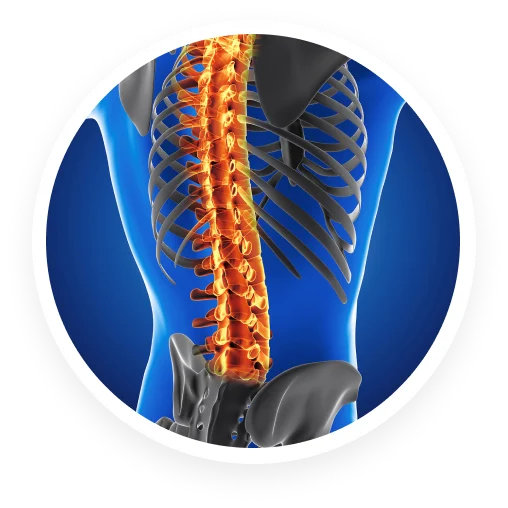
Degenerative Disc Disease
Degenerative disc disease typically starts when a small laceration appears in the disc panel, otherwise known as the annulus. These lacerations or tears may result in pain and discomfort.
Allen Finney
Review
Young ladies behind the counter were nice and professional. Dr. Khan was and is awesome. You felt he really cared which I have not felt in the 2 years I've been injured. Only reason I did not give it 5 stars was the hard time I had finding it.
Allen Finney
Review
Young ladies behind the counter were nice and professional. Dr. Khan was and is awesome. You felt he really cared which I have not felt in the 2 years I've been injured. Only reason I did not give it 5 stars was the hard time I had finding it.
charles griffin
Review
Have been doing a wonderful job with help with my nerve pain, listen to me, and my request no to be put on pain killers but to help find the problem, always return calls so glad is was referred to them.
Stacey Mejia
Review
Awesome staff Dr. Kahn is a really good Doctor he listens and is a helping man!! I appreciate all of your guys work you do for your patients!! You even call to give reminder the day before your appointment! Again that's so awesome!!
Forrest Hammer
Review
NOTHING BUT THE BEST. ABLE TO WALK. ABLE TO PERFORM TASKS THAT I COULDN'T FOR A LONG TIME, LIKE DAILY WALKING, BENDING OVER, CARRYING GROCERIES AND ENJOYING A MOVIE AT THE CINEMA. THANK YOU DR. ASIM KAHN.
Jeanne Neathery
Review
Dr RYklin is amazing. He treats each patient as if you’re his only one. I’ve been seeing him for 7yrs due to a neck injury. He definitely finds what pain management meets your individual needs. The practitioners are amazing as well!!!!
Marty Klopper
Review
Pain Dr office. Staff is friendly and professional. Lots of paper work to be filled out. Office was clean and neat. Masks on Staff at all times and required for patients to enter. Will be going back for follow-up appointments.
Kim LindL
Review
The staff is very pleasant and Dr. Khan is very good with a needle I've been getting epidurals and shots in my foot and lower back for about 4 years now, he is very good and I would never go to another place
Angel Bussert
Review
The doctor actually listens. I have been a patient for years and love the staff and doctors. I've been to all the locations the country club one is always super busy queen creek location is never packed so I go there.
Guy Romero Jr
Review
Every Staff personnel are very professional, courteous and patient respectful in caring for each medical problem. We live out in Laveen, but finding good patient care are hard to find, Truly Blessed Guy E Romero
John Crosby
Review
They do a great job in today's challenging health care system. Great Nurse Practitioners who work hard. Great support staff. Doctors are expert practitioners. Stable practice. I have over five years personal experience with them.
Stacey Mejia
Review
Awesome staff Dr. Kahn is a really good Doctor he listens and is a helping man!! I appreciate all of your guys work you do for your patients!! You even call to give reminder the day before your appointment! Again that's so awesome!!
Kim LindL
Review
The staff is very pleasant and Dr. Khan is very good with a needle I've been getting epidurals and shots in my foot and lower back for about 4 years now, he is very good and I would never go to another place
Guy Romero Jr
Review
Every Staff personnel are very professional, courteous and patient respectful in caring for each medical problem. We live out in Laveen, but finding good patient care are hard to find, Truly Blessed Guy E Romero
Angel Bussert
Review
The doctor actually listens. I have been a patient for years and love the staff and doctors. I've been to all the locations the country club one is always super busy queen creek location is never packed so I go there.
Forrest Hammer
Review
NOTHING BUT THE BEST. ABLE TO WALK. ABLE TO PERFORM TASKS THAT I COULDN'T FOR A LONG TIME, LIKE DAILY WALKING, BENDING OVER, CARRYING GROCERIES AND ENJOYING A MOVIE AT THE CINEMA. THANK YOU DR. ASIM KAHN.
Jeanne Neathery
Review
Dr RYklin is amazing. He treats each patient as if you’re his only one. I’ve been seeing him for 7yrs due to a neck injury. He definitely finds what pain management meets your individual needs. The practitioners are amazing as well!!!!
Marty Klopper
Review
Pain Dr office. Staff is friendly and professional. Lots of paper work to be filled out. Office was clean and neat. Masks on Staff at all times and required for patients to enter. Will be going back for follow-up appointments.
John Crosby
Review
They do a great job in today's challenging health care system. Great Nurse Practitioners who work hard. Great support staff. Doctors are expert practitioners. Stable practice. I have over five years personal experience with them.
Carol Gravatt Davidson
Review
Absolutely the best place I have been too...so many doctors and always just prescribed pain pills for over 10 years. There is hope, after starting injections I feel so much better. I know I'm in the right place.
Tim Tuzon
Review
Been with Kahn for over a year and wouldn't want to be anywhere else. He is not a pharmacy! He solves the issues instead of hiding them with tons of drugs. Have had multiple procedures to correct the problems.
Brooke Keifer
Review
I was nervous when I brought my mom into the office. They are clearly a very busy office, but the front staff was kind, and the doctor was very confident in a treatment plan. Overall my Mom was very pleased with her visit.
Kari Lynn Plo
Review
I love Dr Ryklin and his assistant Liza! They've always been super good to me and very sympathetic to all my needs! They've done everything they can to make me comfortable and to help me with my pain! I'd refer anyone to them!
Lacey Smithson
Review
This office keeps getting better every time I go. Staff is friendly, doctors are very well educated and good at what they do. And they have helped decrease my mom's back pain by 80%! Everyone with pain should go to this place!
Katty Miller
Review
Dr. Khan is truly carrying, understanding and the VERY BEST AT ADMINISTRATING SGB INJECTIONS!!! I look forward to driving from California to be seen by him. I just can't say enough. Thank you Dr. Khan.
Britt Montoya
Review
Great place. Dr Khan is an awesome Dr and goes above and beyond to help you. Meghan is a wonderful P.A. as well. It says so much to have a Dr that truly cares about your outcome of your procedures. This is a goodhearted Dr
Julie Kierzek (Julz)
Review
Love them all. Dr Ryklin is so helpful and understanding. He takes helping people seriously & I'm extremely grateful for everything he & the PA's & MA's have done for me. Dr Ryklin has gone above & beyond for me.
Delicia N
Review
The team here are genuinely the most helpful providers I have ever had. I went through my worst lupus flare ever last year and mentally did not think I would make it. They truly saved me and made me feel like I could ask for help!
Caroline Copeland
Review
We are Dr. Ryklin's patients. He is an amazing pain management physician. All of the treatments that we receive work extraordinarily well. His entire staff, from front to back, are exceptional. Patient care is really the specialty here.
Eva Linda Hemmerling
Review
I'm a patient Dr. Khan/ NP Liza. I find Doc Liza caring always interested in me as a whole. Body/Mind/soul. Find comfort in her. Staff Dustin,Amanda are tops also. I highly recommend AZ Spine Institute. E.L.H.
Charles Eberhardt
Review
I have been to the Vineyard location 12 times and this is the best Doctor's office I have ever been to. The staff is by far the friendliest and most caring staff around. I actually look forward to my visits. Thanks for everything.
Becky Kirby
Review
For the last 12 years, Arizona pain and spine in Queen Creek with Lisa, has taken care of my pain issues. Without her, I wouldn't be able to manage the excruciating pain I have had after my time in the service

What is degenerative disc disease?
As the laceration or tear heals, it will create scar tissue that is normally as sturdy or durable as the native tissue. In the event that the back is frequently subjected to injury, the disc wall will continue to weaken and scarring and tearing may persist.
Over a period of time, the middle of the disc will become damaged which results in the loss of its fluid. The core of the disc and its water content is essential to maintaining the disc’s functionality as a cushion or spring for the spinal column.
When the core of the disc fails to act as a cushion, the center of the disc collapses. This results in the two vertebrae rubbing together.
Over time, the vertebrae will form bone spurs. Should these bone spurs develop inside the spinal canal, they will narrow the canal resulting in the pinching of the spinal cord and nerves which is a condition known as spinal stenosis.
What are the symptoms of degenerative disc disease?
The most common symptom of degenerative disc disease is pain in the neck or back. However, some people with this condition do not experience pain. The following are symptoms of degenerative disc disease.
- Pain when twisting, reaching, bending, or with movement
- Pain that limits your daily activities
- Pain felt from the neck through the arm or hands
- Pain that radiates down the legs or buttocks
- Numbness and tingling
- Weakness in the legs
- Pain that lessens with movement such as walking
What causes degenerative disc disease?
The primary cause of degenerative disc disease is aging. Spinal discs naturally wear down as we age, causing a loss of fluid in our discs. Aging can lead to cracks in our discs as well.
Those with physically demanding occupations are more likely to develop degenerative disc disease. Smoking and obesity can lead to the condition as well. It can also be caused by injury.
Form of Arthritis
The “wear and tear” that occurs with degenerative disc disease is a type of arthritis occurring in the spinal region. The term arthritis refers to inflammation that causes pain, swelling, or impedes movement. Arthritis may occur at any junction or joint where one bone meets another.
Juvenile Disc Degeneration
Some children suffer from degenerative disc disease. Often, these individuals are found to be overweight or obese. Research shows that those with an elevated body mass index are more likely to experience this condition. Many experts believe that genetics may also be a factor.
Children can incur disc damage due to injury. Many characteristics of the condition are similar in both children and adults, with one key exception. Adults tend to have degeneration in only one or two discs, while children generally have degeneration in many discs.
How is degenerative disc disease treated?
Types of Prescription Medications
Prescription-strength non-steroidal anti-inflammatory drugs may be effective in minimizing inflammation. A non-narcotic form of oral steroid is another commonly used option. These products are used over a short period of time with the dosage often reducing over several days. Some muscle relaxers have proven to be effective including Soma and Flexeril which reduce spasms and have a sedative effect.
Physical Therapy
A treatment regimen of physical therapy is often effective for treating degenerative disc disease and other similar conditions. PT is largely based on using body movement to strengthen muscles, such as those in the back and neck regions. The increase in muscle strength adds support and eases the pressure on the spine.
Surgical Treatment
Surgical procedures may be considered when more conservative measures are unsuccessful. Surgery may be a solution when there is significant pain that inhibits daily function. Many suffering from degenerative disc disease may experience numbness in the legs and be too weak to stand or walk comfortably.
Surgery may be considered if a disc has become large enough to create problems with the bladder or bowels. More than 90% of problems with discs will improve to some extent without surgery. Some common procedures that may be used include the following:
- Spinal fusion or stabilization: The process of fusion involves merging two vertebrae. It is most commonly performed in the lower back region or in the neck area for strength and support. One potential drawback is that any adjacent discs may respond by degenerating further.
- Discectomy: This involves removing damaged spinal discs and then performing a spinal fusion to limit movement in that area of the spine.
- Decompression: This surgical option involves removing a part of a disc to relieve pressure.
AZ Pain and Spine Institute
Degenerative Disc Disease Treatments
Here at Arizona Pain and Spine Institute, we improve our patients’ quality of life by alleviating and managing their pain. Some of our Degenerative Disc Disease treatments include:

Why choose AZ Pain and Spine Institute to treat your Degenerative Disc Disease?
We have a team of medical practitioners, pain management doctors, and staff who are experts on pain management, including Degenerative Disc Disease. We use state-of-the-art technology and effective approaches in achieving our mission. We care about your well-being and are committed to making your life pain-free.
